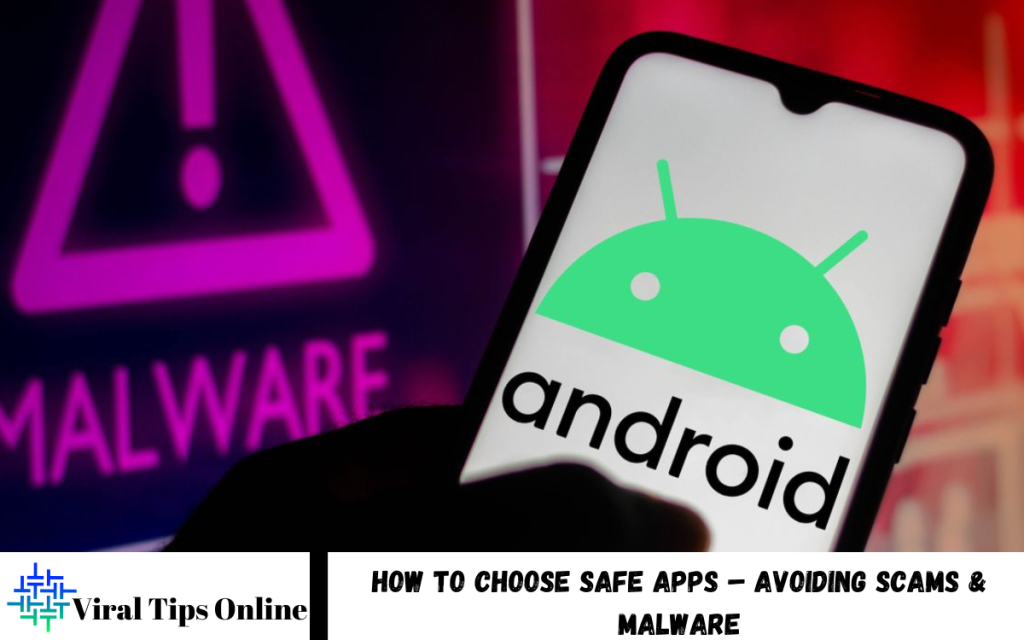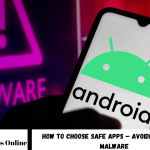Mobile apps have become an essential part of our daily lives whether it’s for communication, entertainment, shopping, or managing finances. However, as app usage increases, so do the risks. Cybercriminals often disguise malicious software as legitimate apps, tricking users into downloading harmful programs that can steal personal information, spread malware, or even lead to financial loss.
Choosing safe apps is more important than ever. By being cautious and learning how to identify trustworthy sources, you can protect yourself from scams and potential cyber threats. This means downloading apps only from official app stores, checking developer details, reading user reviews, and keeping your device’s security settings updated. A little awareness goes a long way in ensuring your digital safety.
Why Choosing Safe Apps Matters?
Many users underestimate the risks of downloading unsafe apps. But here’s why choosing safe apps should be a top priority:
- Data Protection: Unsafe apps often collect personal information such as contacts, banking details, and passwords without consent.
- Financial Security: Some apps contain hidden charges or phishing techniques that target your bank accounts.
- Device Safety: Malware-infected apps can damage devices, slow performance, or allow hackers remote access.
- Peace of Mind: Knowing your apps are safe ensures you can enjoy technology without constant worry.
Common Risks of Unsafe Apps
Malware Infections
Malware is the most common risk associated with unsafe apps. Once installed, malicious apps can track your keystrokes, steal credentials, or even lock your files for ransom.
Phishing and Scams
Some apps mimic legitimate platforms to trick users into entering sensitive information like passwords, social security numbers, or bank details.
Spyware and Privacy Breaches
Many fraudulent apps secretly access your camera, microphone, or location to spy on your activities without permission.
Hidden Subscriptions
Unsafe apps may advertise free services but lock essential features behind costly, recurring subscriptions.
Device Vulnerability
Installing unsafe apps can weaken your device’s security, making it an easy target for hackers.
How to Identify Safe Apps
Download Only from Trusted Sources
Stick to official app stores like Google Play Store or Apple App Store. These platforms have strict security checks, reducing the chance of downloading malicious apps. Avoid third-party sites unless absolutely necessary.
Check Developer Information
Legitimate developers usually provide their official website, contact details, and regular updates. Be cautious if the developer’s information is missing or looks suspicious.
Read Reviews and Ratings
User reviews often reveal whether an app is genuine or fraudulent. Apps with numerous negative reviews, fake-looking comments, or very low ratings are potential red flags.
Examine Permissions
Always review the permissions requested by an app. If a simple flashlight app asks for access to your contacts, location, or messages, it may be unsafe.
Look at Download Numbers
Popular and widely downloaded apps are usually safer. However, this is not a guarantee, so use it as an additional factor, not the sole criterion.
Verify Official Logos and Branding
Fraudulent apps often copy logos of trusted brands but make small design changes. Always double-check the authenticity before installing.
Steps to Protect Yourself from App Scams & Malware
Keep Software and Security Updated
Regularly update your device’s operating system and security patches. Updates fix vulnerabilities that hackers exploit.
Use Antivirus and Security Apps
Installing a reliable mobile antivirus app can detect and block harmful apps before they cause damage.
Enable Two-Factor Authentication (2FA)
Use 2FA on important apps like banking or email. Even if scammers steal your password, they won’t be able to access your account easily.
Avoid Clicking Unknown Links
Never download apps from suspicious links sent through SMS, email, or social media. These are common tactics for spreading malware.
Monitor App Activity
Check which apps consume unusual amounts of data or battery. Excessive resource use may indicate hidden spyware or malware.
Delete Suspicious Apps Immediately
If you suspect an app is unsafe, uninstall it right away and scan your device for threats.
Read Also: Secret Android Apps You Didn’t Know About (2025)
Examples of Past App Scams
- Joker Malware Apps (Google Play Store) – These apps secretly subscribed users to premium services without their consent.
- Fake WhatsApp (WhatsApp Plus) – A clone app that tricked millions into downloading spyware.
- Adware-Infested Games – Seemingly harmless games that secretly displayed malicious ads in the background.
These cases show that even trusted platforms can sometimes let dangerous apps slip through, making user awareness crucial.
Best Practices for Choosing Safe Apps
- Always check official websites for app download links.
- Prefer verified apps with the “Editor’s Choice” or “Top Developer” badge.
- Avoid apps that promise unrealistic rewards like free money or instant followers.
- Regularly clean your device and remove unused apps.
- Stay updated with the latest cybersecurity news about app scams.
Role of AI in Detecting Unsafe Apps
Artificial Intelligence (AI) is playing an increasingly important role in cybersecurity. App stores now use AI algorithms to analyze app behavior, detect unusual activities, and block potential malware before it reaches users. AI-based security tools also help identify phishing patterns and alert users instantly. As these technologies improve, the chances of downloading malicious apps will decrease but personal vigilance is still necessary.
Frequently Asked Questions
Can free apps be dangerous?
Yes, many free apps make money by showing ads, collecting data, or even hiding malware. Always research before downloading.
How can I protect my phone from app-related scams?
Keep your device updated, use antivirus protection, enable two-factor authentication, and download only from trusted sources.
What is the biggest red flag of a scam app?
Unrealistic promises such as free money, instant rewards, or unlimited premium services are major warning signs.
Can malware apps steal my banking information?
Yes, some malware apps are designed to steal financial credentials, track keystrokes, or redirect online payments.
Are third-party app stores safe?
Most third-party stores do not have strict security checks, making them risky. It’s best to avoid them.
How often should I check my apps for safety?
Regularly review your installed apps, delete ones you don’t use, and monitor unusual behavior like excessive data or battery use.
Conclusion
Choosing safe apps is not just about convenience it’s about protecting your personal data, financial security, and peace of mind. While official app stores and security tools provide strong protection, users must also stay alert and cautious. By checking developer details, reading reviews, avoiding unnecessary permissions, and using security apps, you can significantly reduce the risk of falling victim to scams or malware.
In the end, your smartphone or tablet is only as safe as the apps you install. Make informed choices, stay updated on digital safety practices, and remember: if an app looks too good to be true, it probably is.


